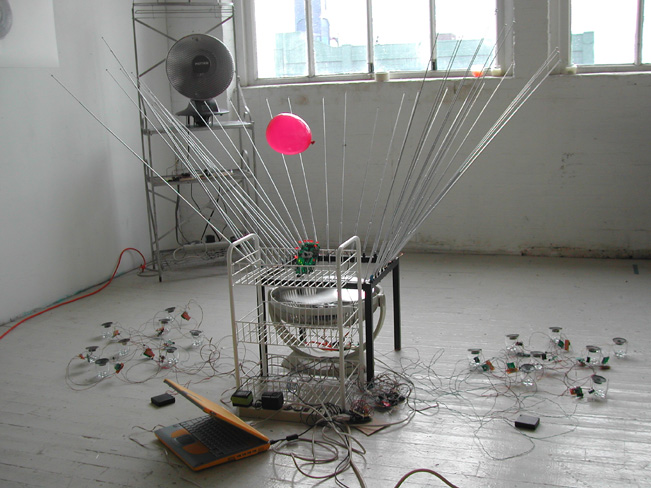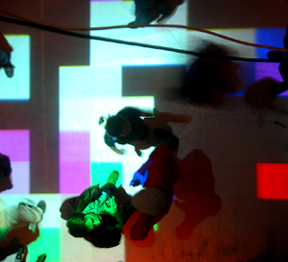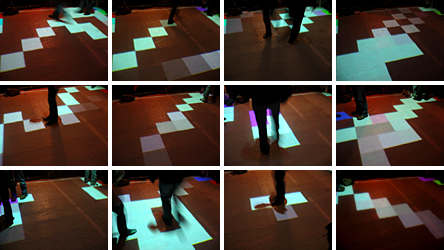


R.I.P.L.T.R.A.N.E., '03-'04
R.I.P.L.T.R.A.N.E. is an acronym for Research, Instructions Programs and Logic for Trans-Robotic Adaptive Networked Environments. It was carried out jointly between NYC and Berlin, and involved classes at both Parsons School of Design in NYC, and the class of Prof. Judith Giesler and Innes Yates (both also of bnode architecture, Berlin) at the T.U. in Berlin (department of architecture). A schematic/flow chart is here, video documentation of both sites is: NYC / Berlin .
The project is an experiment on the theme of an immediate physical environment as layered with information and events occurring locally and at distant geographic and temporal locations. The project has two components: First we will implement an adaptive, real-time network connecting robotic objects/environments in NYC and Berlin over the web; second, we will develop an online resource enabling others to join in. Our intention is to start something that will take on a life of its own.
The official launch date for the project was Mid-December, 2003. We installed and ran the project for the first time, sucessfully, in March of '04. In brief, a Cafe on the campus of the TU (Cafe A) was outfitted with sensors and projectors. The principle sensor was a floor sensor comprised of pressure sensors beneath individual floor tiles. The data from this sensor was processed and lighting and sound effects were created. My studio in Long Island City was also outfitted with custom sensors/effectors: a Fan/fan controller, Balloon, Directional Heater, and the robots from justhere were reprogramed for the installation. Both environments harvested 108 bit strings of data from their respective sensors, and sent that data to a server, where both strings were "&'d". The resulting string was sent back to both environments and processed as sensor data within the local environment. The NYC installation featured a rotating Directional Heater that responded to significant areas of activity within the Berlin floor grid by facing in the compass direction of that activity and projecting heat based on the amount of activity. The balloon was sensed by an emf detector (visible at the top of the white metal structure near the fan) and the strength of the fan was determined by a relationship between cumulative activity in Berlin (floor and PIR detectors) and cumulative emf activity (balloon movement) in NY. I found the movement of the balloon above the fan was an excellent sensor for pedestrian movement within the NYC loft. The sound emitting devices of justhere represented the amount of pedestrian traffic within Cafe A. The data from the NYC space was merged with the Data from Berlin. The piece ran for three days in both cities and was referred to as "Cafe A-loft".
We developed a site that included an online toolkit providing code, parts lists, schematics, and images of all circuitry - along with tutorials on construction and implementation - necessary to participate in this project. For those more experienced in electronics, the site can serve to provide more general information and guidance. As long as certain data protocols are established, you will be able to link your stuff to our stuff - we will provide the vehicle for your environment to influence, and adapt to, other environments. The experiment is our paradigm, and the specifics of each environment, e.g., what the micro-controllers are embedded in, are up to those creating the specific environment. In other words, and as an example, your colony of small, roving robots can adapt their behaviors to the activities within a system of patrons, sensors and environmental controls in a nightclub, as it adapts its behaviors to a wearable bio-feedback device, etc., and so on. The point is to create an adaptive, online environment at the intersection of Human and Machine intelligence, where similarities in code provide opportunities for otherwise disparate elements to co-mingle, merge, and transform.
The internet is an embodiment of an electronically mediated present as a multi-layered, temporal, informational, and causal domain, where, typically, the user is king. R.I.P.L.T.R.A.N.E. seeks to create a multi-layered environment where Human and Machine equally share causal relations. We refer to this as Hybrid Intelligence, and see it as an element of Ubiquitous Computing. Our intention is to foster individual creative activity within this area that may provide other options as we collectively play, build, and become our world.